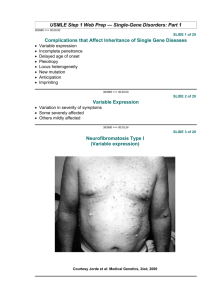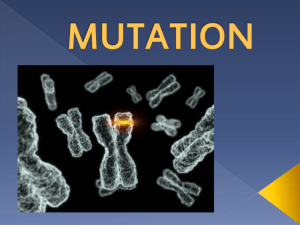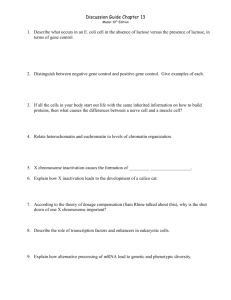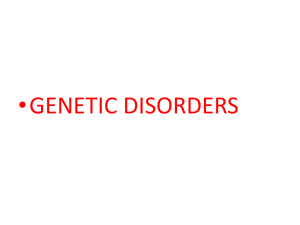mutations - MashreqMYP5BIOLOGY
advertisement
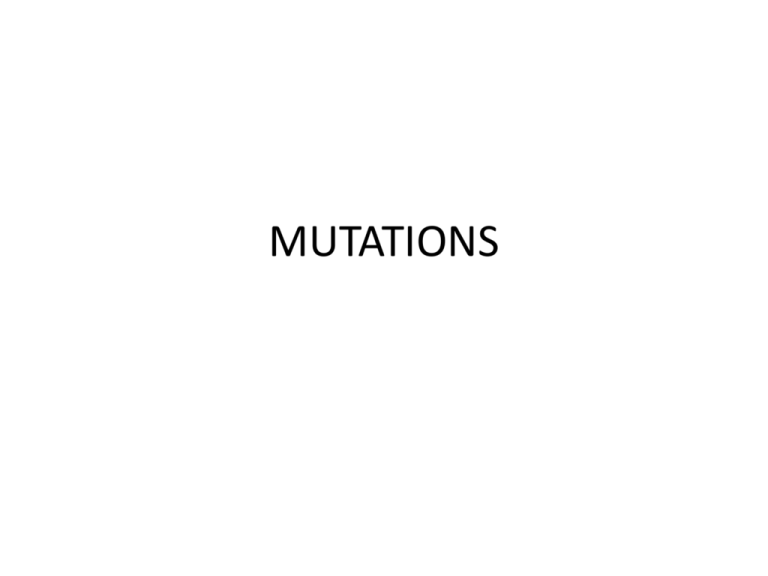
MUTATIONS MUTATION • A mutation, the original source of genetic variation caused by a change in a DNA base or a chromosome. Spontaneous mutations are those that appear without explanation, while induced mutations are those attributed to a particular mutagenic agent. Mutations • Mutation – a change in the DNA message • Mutations cause the wrong protein to be made (they may no longer be functional) • Mutations can have harmful, beneficial, neutral, or uncertain effects on health. Mutations that cause serious disability early in life are usually rare because of their adverse effect on life expectancy and reproduction. • On rare occasions, a mutation results in a new characteristic which can help the organism survive in unfavourable environmental conditions. The new characteristic will be passed to its offspring who can survive where others may die. This is an example of how natural selection and, over a long period, evolution, occurs. The pathogenic mutation alter genetic component and may lead to genetic diseases: • Single gene disorder : component of single gene are altered. • Chromosomal disorders: when the number of chromosome (numerical) or structure (structural) of chromosome is altered. GENE MUTATION • Mutations in a gene's DNA sequence can alter the amino acid sequence of the protein encoded by the gene. • Gene mutations inherited from a parent or acquired during a person’s lifetime. • Mutation inherited as autosomal dominant, autosomal recessive ,or X-linked traits. I- Sickle cell disease • Sickle cell disease is a human genetic disorder. It results from a single base change in the gene for B-globin. The altered base cause insertion of the wrong amino acid into one position of B globin protein. This altered protein results in distortion of red blood cells under low oxygen conditions. • Normal Hb A gene …CTC… …GAG Sickle cell Hb S gene …CAC… …GTG… …GAG… mRNA …GUG... …Glu… Protein …Val…. Sickle cell anaemia – A mutation caused a GAG codon to change into a GUG codon in the gene for one of the protein chains of hemoglobin – mutation replaced the glutamic acid a2 with valine – Conseqences = hemoglobin stick together and causes damage to RBC = anemia – The mutation also gives some resistance to malaria in individuals with one sickle gene and one normal gene Autosomal recessive • AlbInism = the lack of pigmentation in skin, hair, and eyes • 1) the lack of enzyme along the melaninproducing pathway; • or 2) the inability of the enzyme to enter the pigment cells and convert the amino acid tyrosine into melanin. Autosomal dominant • Huntington’s disease - progressive destruction of brain cells. • The disease usually does not manifest until after age 20-30. • Polydactly is the presence of a sixth digit common with this trait. Sex linked • Red-green colorblindness. 8% M, 0.04% F. X. • Hemophilia- defective blood clotting protein • Muscular dystrophy- DMD. 1 in 35,000. Muscle wasting disease. NUMERICAL ABNORMALITIES Example • Down Syndrome (Trisomy 21) (an individual with Down Syndrome has three copies of chromosome 21, rather than two). • Turner Syndrome is an example of MONOSOMY, where the individual (female ) is born with only one sex chromosome, an X. Variation in chromosome number • • • • • • • Aneuploidy = gain or loss one or more chr. Monosomy = 2n – 1. eg. 45X Trisomy = 2n + 1. Euploidy = complete haploid set of chr (x) Polypliody = more than 2 sets of chr. Triploid = 3 sets Tetraploid = 4 sets. Klinefelter syndrome • • • • • • • • Aneuploidy = Extra X chromosome (XXY). 2 in 1000 male births. Lower incidence that 47XXY Sex ? Intersexuality Male genitalia and internal ducts but testes rudimentary and X produce sperm. Tall, long arms/legs, large hands/ feet. Gynecomastia and rounded hips. Intelligence below normal range. Y chromosome determines maleness. • As XXY males enter puberty, they often don't make as much testosterone as other boys. This can lead to a taller, less muscular body, less facial and body hair, and broader hips than other boys. As teens, XXY males may have larger breasts, weaker bones, and a lower energy level than other boys. • By adulthood, XXY males look similar to males without the condition, although they are often taller. They are also more likely than other men to have certain health problems, such as autoimmune disorders, breast cancer, vein diseases, osteoporosis, and toothdecay. • Between 95 percent and 99 percent of XXY males are infertile because their bodies don't make a lot of sperm. XXX karyotype • 47XXX. 1 in 1200 female. • Extra X chr appears to disrupt the balance of gen info needed for female developmt. • Some may be normal, others may have underdeveloped sex chrtc, sterility and mental impairment. • 48XXXX • 49XXXXX. Monosomy • Turner syndrome 45X. • 1 in 2000 female births. • Female genitalia and internal ducts, ovaries rudimentary. • Short stature, broad chest, skin flaps back of the neck, underdeveloped breasts. • Sex ?. Description Normal Females xx Turner Syndrome Females x Wide and Webbed Neck Swollen Feet Short Structure Shortened meta carpal Small Finger Nails Loss of Hair Shortened 4th & 5th Meta Carpal TRISOMY 18 • Edwards syndrome = Trisomy 18 • Infants smaller than average newborn. • Congenital malf, death within 4 mths. (Pneumo) KARYOTYPE BABIES WITH EDWARDS SYNDROME DOWN’S SYNDROME Down Syndrome (Trisomy 21) Down syndrome is the most common cause of mental retardation and malformation in a newborn. It occurs because of the presence of an extra 21st chromosomes. It was first described in 1866 by Dr.John. L.H. Down, an English Physician. Incidence Down syndrome occurs about once in every 800 births. It is estimated that 10,000 children are born with down syndrome each year in the India. Causes increased maternal age Parents with chromosomal disorders Hereditary Chromosomal mutation Karyotyping CLINICAL MANIFESTATIONS Mangolion Face Simian Crease Flattened Nose and Face, Upward Slanting Eyes Short Fifth Finger that curves inward Increased space between 1st and 2nd toe Evolution • In biology, evolution is the process of change in the inherited traits of a population of organisms from one generation to the next. • Mutations in genes can produce new or altered traits in individuals, resulting in the appearance of heritable differences between organisms, but new traits also come from the transfer of genes between populations, as in migration, or between species, in horizontal gene transfer, In species that reproduce sexually, new combinations of genes are produced by genetic recombination, which can increase the variation in traits between organisms. • Evolution occurs when these heritable differences become more common or rare in a population .

